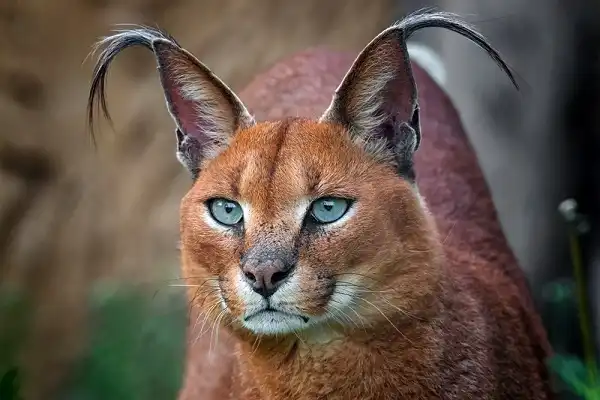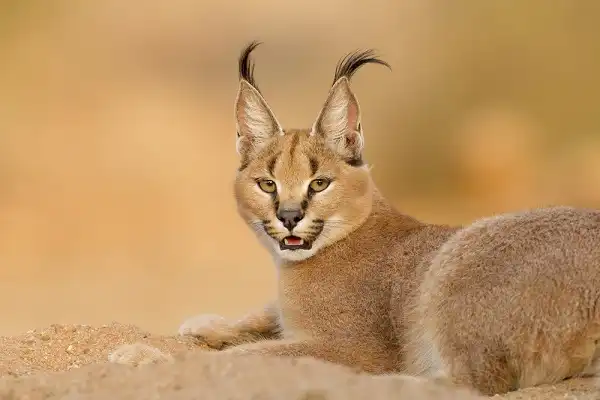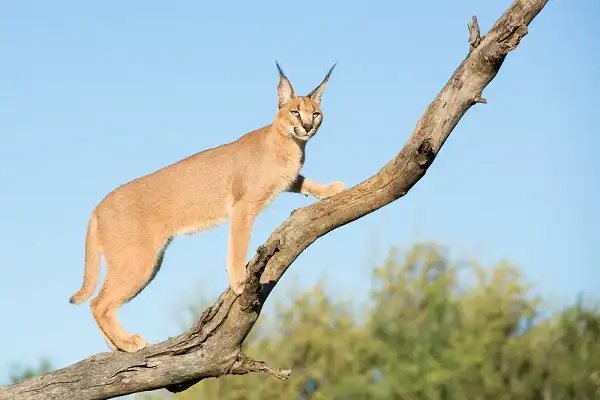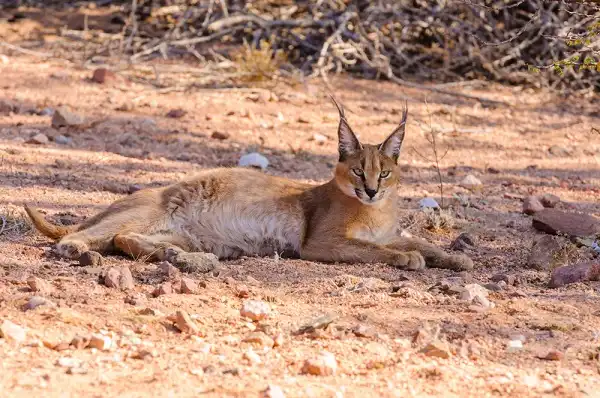Have you ever heard of a caracal? This exotic, wild cat is native to Africa and Central Asia, but the majority of its population can be found in the desert. The caracal has breathtakingly beautiful features including a spotted coat and vivid orange eyes – not to mention it’s an excellent hunter! Its unique abilities make it one of the most fascinating cats on Earth, so read on for more information about this rare species.

Caracal Description
The caracal, also known as the desert lynx, is a medium-sized wild cat. The caracal’s most distinctive features are its tufted black ears and its long slender legs. The cat’s coat is short and usually a reddish-brown color with black spots on its belly and the underside of its legs. They have large, expressive eyes that are golden to dark reddish-brown. Unfortunately, these beautiful creatures are considered threatened due to habitat loss, hunting, and poaching for their fur and body parts. Nonetheless, organizations like the Caracal Awareness Program are working to educate the public and protect caracal habitats to ensure their survival. Overall, the caracal is a magnificent and unique cat that deserves our admiration and protection.
Caracal Habitat
The caracal, also known as the desert lynx, is a wild cat of stunning beauty and agility that inhabits a wide range of ecosystems, from deserts and savannas to forests and scrublands, in Africa and Central Asia. These cats are highly adaptable and can survive in various habitats as long as they have access to water and prey. In Africa, caracals can be found in the Sahara and Kalahari deserts, the savannas of Eastern and Southern Africa, the grasslands of Ethiopia, and the wooded areas of Central Africa. In Asia, they can be found in Iran, Turkmenistan, and other countries of the Arabian Peninsula. Despite their wide distribution, caracals are becoming increasingly threatened due to habitat destruction and fragmentation caused by human activities, such as farming, mining, and urbanization. In addition, these cats are often hunted for their fur, which is highly prized, and their body parts, which are used in traditional medicine.
Caracal Diet
The caracal is a carnivore with a formidable reputation as a hunter. Their diet consists of small mammals, including rodents, hares, and other small mammals, as well as birds, reptiles, and insects. They are particularly adept at hunting birds in flight, leaping high into the air to capture their prey in mid-flight. These cats have a specialized hunting technique, which involves stalking and waiting for prey before pouncing and taking it down with a single bite to the neck or skull. One interesting fact about the caracal’s diet is that they are known to hunt animals much larger than themselves, such as adult gazelles and antelopes, which can weigh up to 10 times their own body weight. They are able to do this due to their incredible speed, agility, and strength. Their powerful hind legs allow them to launch themselves at great distances, while their sharp claws and jaws enable them to quickly grab and kill their prey.

Caracal Size
The caracal is a medium-sized wild cat with a muscular build and distinctive long black tufted ears. They typically measure between 65 and 90 cm in length and can weigh up to 19 kg, with males being larger than females. Despite their relatively small size compared to other predators, caracals are incredibly powerful and agile, with a unique bone structure that allows them to spring high into the air to capture prey. One interesting fact about caracals is that they have incredibly large hindquarters, which give them the explosive power needed for their impressive jumps. Their hind legs are long and slender, with powerful muscles that allow them to leap distances of up to 12 feet in a single bound.
Caracal Lifespan
The lifespan of caracals varies depending on their habitat and living conditions. In the wild, these cats typically live for around 12 years, but some individuals have been known to live up to 17 years. Factors such as food availability, disease, and predation can all impact the lifespan of caracals. In areas where food is abundant and predation is low, caracals may live longer than in areas where resources are scarce and competition for food is high. Interestingly, caracals in captivity often have longer lifespans than those in the wild. This is due to the fact that they receive regular veterinary care, a consistent food supply, and protection from predators and other external threats. Another important factor that can influence the lifespan of caracals is their reproductive success. Females typically give birth to litters of 1-6 kittens, which they raise on their own for the first few months of their lives. Caracals reach sexual maturity at around 2-3 years of age and may breed every year if conditions are favorable.
Caracal Behavior
Caracals are fascinating creatures, known for their distinct physical features and impressive hunting abilities. But in addition to their physical adaptations, caracals also have a unique set of behaviors that allow them to thrive in their ever-changing environments. One of the most notable behaviors of the caracal is their solitary nature. Unlike many other cat species, caracals spend the majority of their lives alone, only coming together to mate or during the early stages of kitten rearing. This independence is likely a result of their territorial nature, as caracals have been known to defend their hunting grounds fiercely from other intruders. In addition to their territorial behavior, caracals have also been observed engaging in a variety of hunting strategies. Their powerful legs and explosive jumps enable them to catch prey in mid-air, such as birds or squirrels.
They are also skilled at stalking and ambushing their prey, using their sharp claws and teeth to deliver swift and deadly blows. Interestingly, caracals have been observed engaging in play behavior, which is unusual for solitary animals. This play can take many forms, including chasing after insects, rolling around in the grass, or mock-fighting with other caracals. It is thought that this type of play behavior may help caracals to hone their hunting skills and maintain their physical fitness. Another interesting behavior of the caracal is their vocalizations. While they are generally quiet animals, caracals have been known to communicate with each other using a range of vocalizations, including growls, hisses, and purrs. These sounds are thought to play a role in mating behavior and territory defense, as well as general social interactions between individuals.

Caracal Speed
Caracals are one of the fastest wild cats, known for their incredible speed and agility. Their strong legs and muscular bodies allow them to run at impressive speeds, reaching up to 50 miles per hour in short bursts. This makes them highly effective hunters, able to catch prey with incredible precision and skill. Their explosive speed is also due to their unique biomechanics. Caracals have a specialized spine that allows them to rotate their hind legs inwards, creating a spring-like effect that helps to propel them forward with incredible force. This is a unique adaptation that has allowed them to become one of the most efficient sprinters in the animal kingdom. Overall, the caracal’s speed is a crucial aspect of their biology and ecology, allowing them to survive and thrive in some of the harshest environments on Earth. Whether they are sprinting across the savanna, leaping into the air to catch prey, or working together to bring down larger animals, caracals are truly remarkable animals that continue to amaze us with their incredible abilities.
Caracal Hunting
The caracal is a master hunter, able to use its agility and cunning to outsmart even the most elusive of prey. While they rely heavily on their speed and strength, caracals also have several unique hunting strategies that help them become successful predators. One of the most impressive hunting techniques employed by caracals is their aerial acrobatics. Caracals are able to leap up to 3 meters into the air and catch birds and other small mammals in mid-flight. This remarkable ability is due to the cat’s long back legs, which allow them to generate incredible force for take-off. In addition to their aerial prowess, caracals are also highly skilled ground hunters. They often stalk their prey, using their keen senses to detect even the slightest sound or movement. Once they have determined the location of their prey, caracals will approach cautiously and then quickly pounce on unsuspecting animals with lightning speed.
Caracal vs. Lynx:
Caracals and lynxes are both members of the feline family, but there are a few key differences between them. Caracals are smaller than lynxes, with a slimmer build and shorter legs. They also have long ears that end in tufts of dark fur, while lynxes have short rounded ears without fur tufts. In terms of coat coloration, caracals tend to be tawny brown or grayish-red in hue, while lynxes usually have thicker coats which can range from light yellow to blackish brown. The most important difference between caracals and lynxes is their hunting habits. Caracals rely heavily on their speed and agility when hunting, using their powerful legs to leap into the air and catch birds or small mammals in mid-flight. On the other hand, lynxes are stealthier hunters that use their patience and strength to ambush prey from hiding spots. Overall, caracals and lynxes both have unique adaptations that make them successful predators, but there are key differences between them. From coat coloration to hunting strategies, these two species of feline have distinct characteristics that set them apart.
Caracal Reproduction
Caracals are solitary animals that live and hunt alone, only coming together to mate during the breeding season. Females will leave scent marks in their territory to advertise their availability for mating, and males will compete with one another for access to these females. Once a successful match is made, mating typically lasts between 10-30 minutes. Gestation is approximately 70 days long, after which a litter of 1-4 kittens is born. The kittens are born blind and helpless, but they quickly develop the skills needed for hunting by around 2 months old.

Conclusion
The caracal is an incredible predator, capable of reaching lightning-fast speeds and using its agility and strength to outsmart even the most elusive of prey. Their powerful legs and specialized spine allow them to generate immense force for running and leaping, while their finely tuned senses give them the edge when hunting. The caracal’s speed and hunting abilities are truly remarkable, making it one of the most impressive animals in the animal kingdom. From their ability to launch themselves into mid-air to their unique cooperative hunting strategies, caracals are fascinating creatures that continue to amaze us with their versatile behaviors.
Frequently Asked Question

